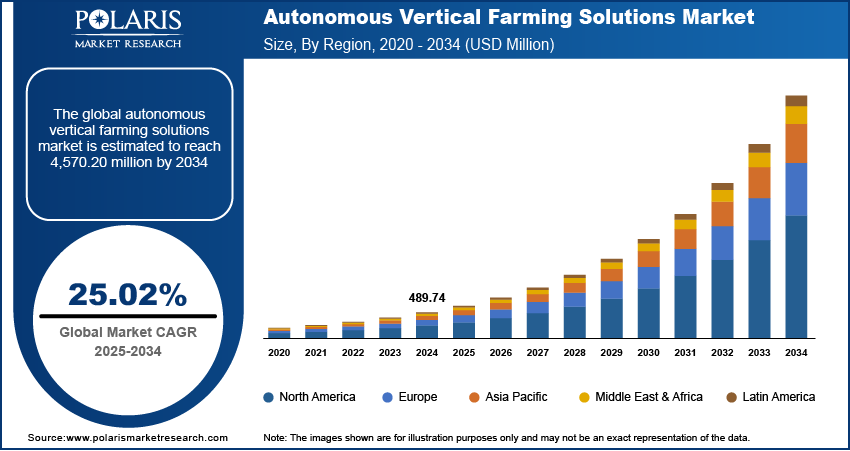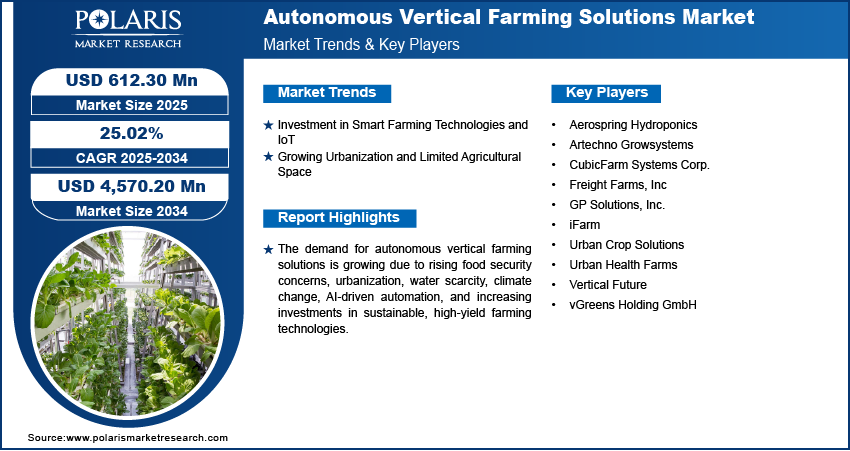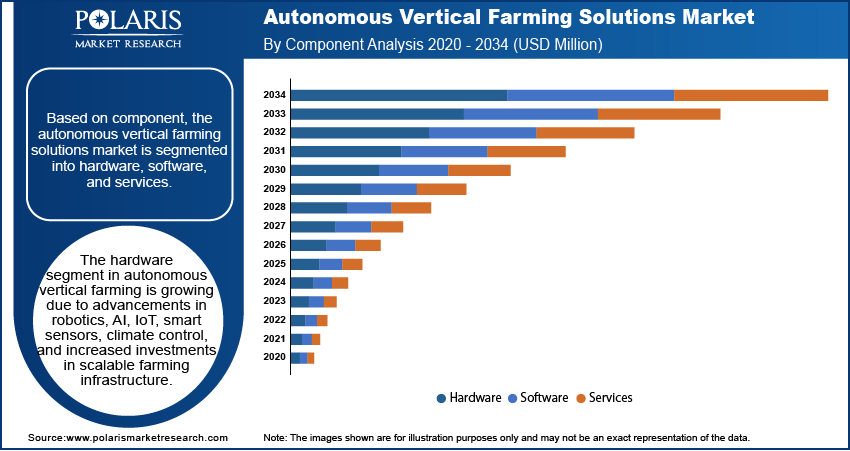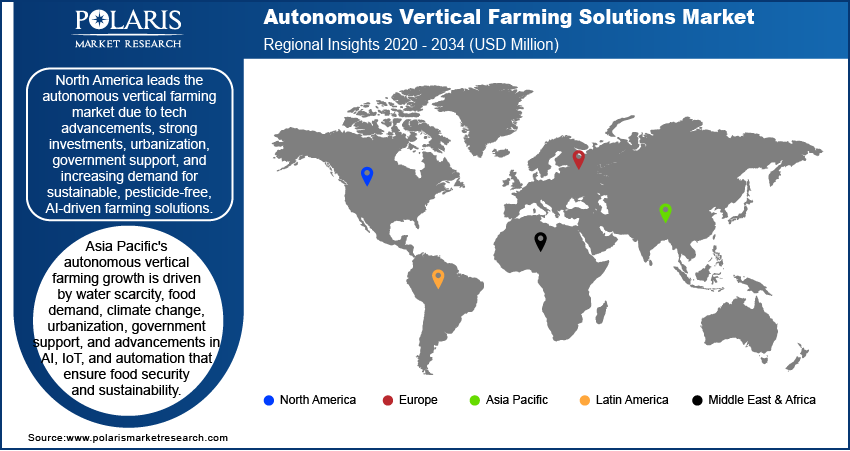
Autonomous Vertical Farming Solutions Market Size, Share, Trends, Industry Analysis Report: By Component (Hardware, Software, and Services), Type, Technology, and Region (North America, Europe, Asia Pacific, Latin America, and Middle East & Africa) – Market Forecast 2025–2034
- Published Date:Apr-2025
- Pages: 128
- Format: PDF
- Report ID: PM5546
- Base Year: 2024
- Historical Data: 2020-2023
Autonomous Vertical Farming Solutions Market Overview
The global autonomous vertical farming solutions market size was valued at USD 489.74 million in 2024. The market is projected to grow from USD 612.30 million in 2025 to USD 4,570.20 million by 2034, exhibiting a CAGR of 25.02% during 2025–2034.
Autonomous vertical farming solutions refer to advanced agricultural systems that integrate automation, robotics, and artificial intelligence to optimize indoor crop production. These solutions enable precise monitoring and control of environmental factors such as light, temperature, humidity, and nutrients, leading to higher yields and reduced resource consumption. The increasing adoption of these technologies is driving autonomous vertical farming solutions market growth, as they offer a sustainable and efficient approach to food production, especially in urban areas with limited arable land.
The rising global population is placing immense pressure on food production systems, necessitating innovative solutions to meet growing demand. Traditional farming methods struggle to keep pace with urbanization and climate change, creating an urgent need for reliable alternatives. The market expansion is being fueled by the ability of these systems to produce fresh, high-quality crops in controlled environments, ensuring year-round supply without dependency on seasonal conditions.

To Understand More About this Research: Request a Free Sample Report
Enhanced resource efficiency through automation and AI is further accelerating demand in this market. Automated systems reduce water usage, minimize waste, and optimize energy consumption, making vertical farms more cost-effective and environmentally sustainable. AI-driven analytics provide real-time insights, improving productivity and reducing operational costs. These advantages contribute to autonomous vertical farming solutions market growth, attracting investments from agribusinesses, tech firms, and government initiatives.
The increasing demand for sustainable food production, combined with advancements in automation and AI, is shaping the future of agriculture. The ongoing expansion of the market reflects a global shift towards technology-driven farming, which addresses food security challenges while promoting sustainability and efficiency.
Autonomous Vertical Farming Solutions Market Dynamics
Investment in Smart Farming Technologies and IoT
Governments and private sectors are prioritizing efficiency, sustainability, and precision agriculture to strengthen food security and optimize resources. For instance, in February 2025, Thailand introduced “HandySense B-Farm,” an AI and IoT-powered smart farming platform developed by NECTEC to enhance agricultural productivity through real-time data analysis, smart sensors, and digital technology.
Technological advancements are unlocking significant opportunities in the market, enabling farmers to optimize crop yields with minimal human intervention. AI-driven automation, climate regulation, and real-time monitoring improve resource efficiency, reduce waste, and ensure consistent production. Rising investments and rapid technological progress are accelerating the adoption of autonomous systems, positioning vertical farming as a revolutionary force in global food production. The increasing emphasis on smart farming and IoT is fueling the autonomous vertical farming solutions market demand.
Growing Urbanization and Limited Agricultural Space
The autonomous vertical farming solutions market growth is accelerating as cities expand, and fertile cropland is lost, particularly in Asia and Africa, threatening food security. Climate change further exacerbates the crisis, with droughts, desertification, and water scarcity forcing rural populations to migrate. For instance, the Chad River Basin's depletion has left millions struggling, intensifying migration. Traditional farming faces resource limitations, making sustainable alternatives essential. Autonomous vertical farming offers a viable solution, maximizing yield in limited urban spaces while reducing water usage and environmental impact. The growing urbanization and shrinking agricultural land are driving demand for innovative farming methods.

Autonomous Vertical Farming Solutions Market Segment Analysis
Autonomous Vertical Farming Solutions Market Assessment by Component
The global autonomous vertical farming solutions market segmentation, based on component, includes hardware, software, and services. The hardware segment is expected to witness significant market growth due to advancements in robotics, IoT, and AI-driven automation. The demand for smart sensors, climate control systems, and automated irrigation is increasing as growers strive for greater efficiency and productivity. The integration of machine vision and robotic arms enhances precision in planting, monitoring, and harvesting, thereby reducing reliance on labor. The widespread adoption of LED lighting solutions optimizes photosynthesis, which accelerates plant growth. Additionally, rising investments in modular and scalable farming infrastructure further boost the market. Enhanced data analytics capabilities improve yield predictions and resource management, making hardware a crucial element in the expansion of autonomous vertical farming. Trends in urban agriculture and concerns about sustainability are driving innovation in this sector, ensuring continued growth in the market.
Autonomous Vertical Farming Solutions Market Evaluation by Type
The global autonomous vertical farming solutions market segmentation, based on type, includes hydroponic, aeroponic, and aquaponic. The hydroponic segment held a significant autonomous vertical farming solutions market share due to its efficiency in resource utilization and high crop yield potential. Water-based cultivation systems minimize soil dependency, reducing the risk of pests and diseases. Controlled nutrient delivery enhances plant growth, ensuring faster harvest cycles and consistent quality. Increasing urbanization and shrinking arable land drive demand for hydroponic farming, making it a preferred choice for vertical farms. Advanced automation in nutrient monitoring, pH regulation, and climate control optimizes crop production while lowering operational costs. Rising investments in sustainable agriculture and eco-friendly farming practices strengthen the hydroponic segment's dominance. The ability to grow diverse crops in compact spaces further accelerates adoption, solidifying market presence.

Autonomous Vertical Farming Solutions Market Regional Analysis
By region, the study provides autonomous vertical farming solutions market insight into North America, Europe, Asia Pacific, Latin America, and the Middle East & Africa. North America holds a substantial market share due to rapid technological advancements and strong investment in agri-tech innovations. The increasing demand for locally grown, pesticide-free produce is driving the adoption of automated farming solutions. Urbanization and the limited availability of arable land are encouraging the development of vertical farms that are equipped with AI, robotics, and IoT-driven systems. Supportive government policies and funding for sustainable agriculture are contributing to market expansion. Additionally, the presence of key industry players and research institutions is accelerating innovation in automation and hydroponics. Growing consumer awareness of food security and environmental sustainability is further strengthening the region’s leadership in autonomous vertical farming solutions.
Asia Pacific is experiencing substantial autonomous vertical farming solutions market growth due to rising water scarcity and increasing food demand from large populations in India, China, and Japan. Climate change impacts, including reduced rainfall and frequent crop failures, drive the need for innovative farming methods. Governments and private investors are supporting advanced agricultural technologies to ensure food security. Companies such as Aerospring Hydroponics are introducing aeroponic systems that enhance yield while conserving resources. Rapid urbanization and shrinking arable land further accelerate the adoption of vertical farming. Technological advancements in AI, IoT, and automation strengthen the region’s position in autonomous vertical farming.

Autonomous Vertical Farming Solutions Market – Key Players and Competitive Analysis Report
The autonomous vertical farming solutions market is witnessing intense competition as key players focus on innovation, strategic partnerships, and expansion to strengthen their market presence. Companies are investing heavily in research and development to enhance automation, improve crop yield, and optimize resource efficiency. Mergers, acquisitions, and collaborations with technology providers are accelerating market growth. Cost-effective production, scalability, and sustainability are crucial for maintaining a competitive edge. Manufacturing locally to reduce operational expenses and improve supply chain efficiency is a common strategy. Leading market players driving innovation and expansion include Freight Farms, Inc; iFarm; Aerospring Hydroponics; CubicFarm Systems Corp.; GP Solutions, Inc.; Artechno Growsystems; Vertical Future; vGreens Holding GmbH; Urban Health Farms; and Urban Crop Solutions. These companies are pioneering advanced farming technologies, leveraging AI, IoT, and robotics to meet the increasing demand for sustainable and high-yield food production solutions globally.
Freight Farms, Inc. specializes in modular, hydroponic vertical farms housed in shipping containers, offering sustainable and efficient farming solutions. Its key offerings include the Greenery farm, Farmhand automation software, and comprehensive training and support services. Farmhand enables remote monitoring, data analysis, crop scheduling, and community collaboration for optimized vertical farming operations.
vGreens Holding GmbH is a vertical farming company that specializes in fully automated vertical farms powered by AI-driven farm management software. Its technology optimizes environmental conditions to produce premium-quality strawberries for fruit and vegetable cultivation. The company's advanced solutions include hydroponic systems, harvesting robots, and laser scanning for crop monitoring. The company focuses on sustainability, urban-near production, and year-round, pesticide-free food supply for the agricultural and food sectors.
List of Key Companies in Autonomous Vertical Farming Solutions Market
- Aerospring Hydroponics
- Artechno Growsystems
- CubicFarm Systems Corp.
- Freight Farms, Inc
- GP Solutions, Inc.
- iFarm
- Urban Crop Solutions
- Urban Health Farms
- Vertical Future
- vGreens Holding GmbH
Autonomous Vertical Farming Solutions Market Developments
January 2025: Oslo-based AgriTech startup Avisomo secured USD 5.45 million, including a USD 1.74 million grant from Innovation Norway, to advance its fully automated vertical farming technology for sustainable food production.
July 2024: iFarm announced the expansion of its business by constructing a high-tech vertical farm in Switzerland, utilizing its StackGrow technology for enhanced productivity and automation. The farm will produce fresh greens, saving costs and doubling yields.
Autonomous Vertical Farming Solutions Market Segmentation
By Component Outlook (Revenue, USD Million, 2020–2034)
- Hardware
- Software
- Services
By Type Outlook (Revenue, USD Million, 2020–2034)
- Hydroponic
- Aeroponic
- Aquaponic
By Technology Industry Outlook (Revenue, USD Million, 2020–2034)
- Fully Autonomous
- Semi-Autonomous
By Regional Outlook (Revenue, USD Million, 2020–2034)
- North America
- US
- Canada
- Europe
- Germany
- France
- UK
- Italy
- Spain
- Netherlands
- Russia
- Rest of Europe
- Asia Pacific
- China
- Japan
- India
- Malaysia
- South Korea
- Indonesia
- Australia
- Rest of Asia Pacific
- Middle East & Africa
- Saudi Arabia
- UAE
- Israel
- South Africa
- Rest of Middle East & Africa
- Latin America
- Mexico
- Brazil
- Argentina
- Rest of Latin America
Autonomous Vertical Farming Solutions Market Report Scope
|
Report Attributes |
Details |
|
Market Size Value in 2024 |
USD 489.74 Million |
|
Market Size Value in 2025 |
USD 612.30 Million |
|
Revenue Forecast by 2034 |
USD 4,570.20 Million |
|
CAGR |
25.02% from 2025 to 2034 |
|
Base Year |
2024 |
|
Historical Data |
2020–2023 |
|
Forecast Period |
2025–2034 |
|
Quantitative Units |
Revenue in USD Million and CAGR from 2025 to 2034 |
|
Report Coverage |
Revenue Forecast, Market Competitive Landscape, Growth Factors, and Industry Trends |
|
Segments Covered |
|
|
Regional Scope |
|
|
Competitive Landscape |
|
|
Report Format |
|
|
Customization |
Report customization as per your requirements with respect to countries, regions, and segmentation. |
FAQ's
The global autonomous vertical farming solutions market size was valued at USD 489.74 million in 2024 and is projected to grow to USD 4,570.20 million by 2034.
The global market is projected to register a CAGR of 25.02% during the forecast period.
North America held a substantial autonomous vertical farming solutions market share in 2024.
A few key players in the market are Freight Farms, Inc; iFarm; Aerospring Hydroponics; CubicFarm Systems Corp.; GP Solutions, Inc.; Artechno Growsystems; Vertical Future; vGreens Holding GmbH; Urban Health Farms; and Urban Crop Solutions are among the key major players.
The hardware segment is projected to grow significantly in the autonomous vertical farming solutions market during 2025–2034
The hydroponic segment held a significant market share in 2024.
